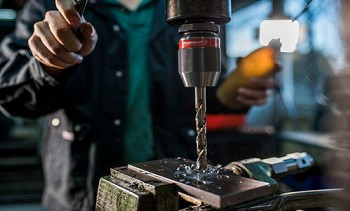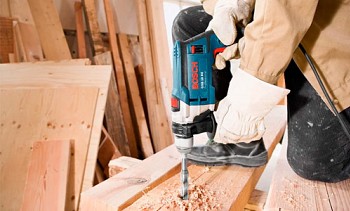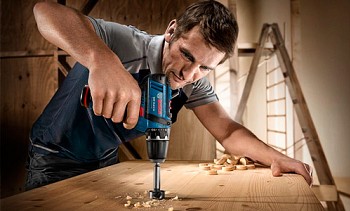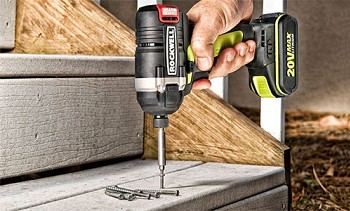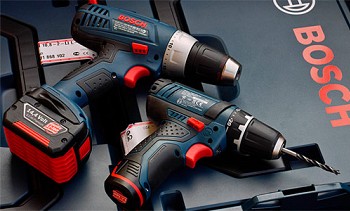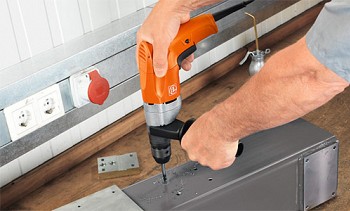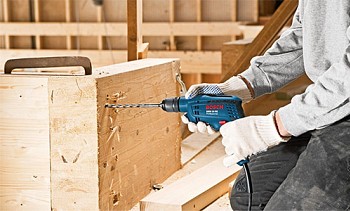Types of drills - we select a tool for drilling metal, wood, concrete and tile
Drills are used to create holes or recesses in any material. This is due to the movement of the cutting edge along the axis, which at the same time rotates. In addition to making a new hole, an old one with an insufficient diameter can also be expanded with a drill. The process of making a hole is called drilling, its expansion - drilling. If only a deepening is done, it is about drilling. By design, different types of drills are very significantly different from each other. Next, consider what they are.
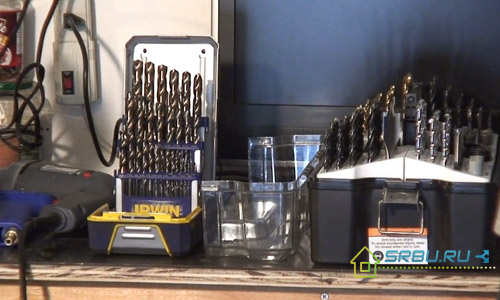
Varieties of drills - the main parameters
Type and form of the working part
1. A screw drill, also called a spiral drill, is most often used in everyday life. With this tool, the length of which can reach 27.5 centimeters, you can drill both wood and other materials. Spiral drills with a diameter of 0.1 mm to 8 centimeters are produced.
2. A pen-shaped flat drill, hence the second name, a feather, is used to drill large and deep holes. The cutting edge is made in the form of a scapula. It can be made integral, together with the shank, and can be attached using a boring bar or a special holder.
3. For deep drilling. If you have to drill a particularly deep hole, the depth of which exceeds 5 drill diameters, use a long drill with 2 screw channels. A special emulsion flows through these channels, cooling the tool during operation. The channels are made either inside the drill or inside the tubes soldered to its back.
4. Single-sided drill. When the hole to be manufactured must have particularly precise dimensions, a drill is used that is designed to be cut on only one side. It has a reference plane, and both edges for cutting are located on one side of the central axis of the tool.
5. The core drill is hollow inside. Due to this design, it drills only a narrow ring in the material. These are the so-called crowns.
6. To make a center hole in the part, a special drill called a center drill is used.
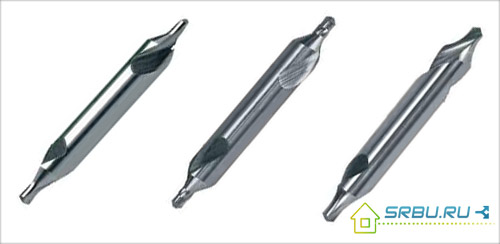
Shank design
There are several varieties of the tail of this tool. We list them. So, the shank is:
- Made in the form of a cylinder;
- made in the shape of a cone;
- faceted having three, four or six faces;
- type SDS.
Drill manufacturing method
The drill can be made of a single piece of metal (with a diameter of not more than 8 millimeters) or an alloy (with a diameter of up to 6 millimeters). In this case, special steel is used, which has the name "quick cutting". Her brands: P9K15, P18 or P9.
If the diameter of the drill is more than 8 millimeters, then it is made by welding. At the same time, the part that cuts is made of high-speed steel, and the shank is made of carbon steel.
When it comes to drilling fragile and brittle materials, use a drill equipped with carbide inserts. There are grooves on it, which can be straight, beveled or screw type.
What shape the hole needs to be processed
Depending on the task being performed, the purpose of the drills differs. So, according to the shape of the hole, they are divided into the following types:
- Conical;
- square;
- stepped;
- cylindrical.
What drill covers
1. The cheapest coating is a black oxide film.It protects the tool from rust and also protects it from overheating. The life of the drill naturally increases.
2. The titanium nitride ceramic coating is very durable. It extends the life of the instrument no less than 3 times. A TiN-coated drill cannot be sharpened, otherwise all of its benefits will come to naught.
3. Drills coated with TiAlN - titanium aluminum nitride - are characterized by even higher quality and reliability. At the same time, such a drill can operate up to 5 times longer than usual.
4. Titanium carbonitride, or TiCN, is considered to be of approximately the same quality.
5. When working with high hardness material, such as porcelain stoneware or stone, you need to use the most durable drills - with a diamond coating. They have no equal in strength.
We drill different materials with different drills
We work on metal
1. If you have to make holes in non-ferrous metal, cast iron, steel, use spiral drills. Along the grooves machined in them, the shavings formed during operation leave. It should be noted that the types of drills for metal differ from each other not only in material and coating, but also in the type of shank. It can be made in the form of a cone, cylinder or hexagon. To attach cylindrical drills you need a cartridge, conical inserts are inserted easier - right into the machine.
The quality of the drill can also be determined by eye - for this, take a closer look at its color. So, ordinary drills of low quality have an inconspicuous gray color.
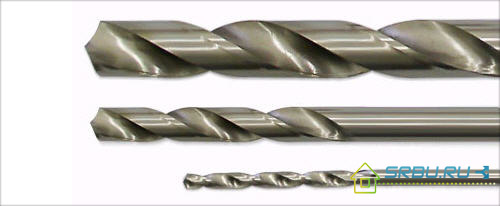
But the drill of black color is more durable - this means that it was processed at the end of production with superheated steam.
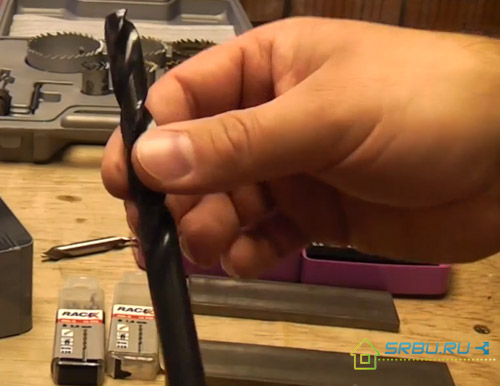
A light shade of gold has a tool that was processed using tempering, relieving internal stress.
And if the drill glistens brightly with gold, then it has a coating of titanium nitride. Such a drill will serve faithfully for a long time, and its friction is reduced due to coating. Although its price is higher than that of other types of drills, the quality more than pays for it.
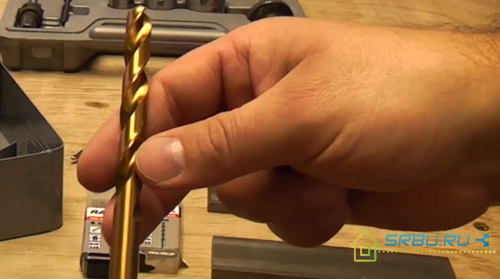
2. Carbide drills. Since metals have different densities, different drills must be used for their processing. Hard materials such as heat-resistant steel, cast iron or non-ferrous metal require the use of a tool made of hard alloy.
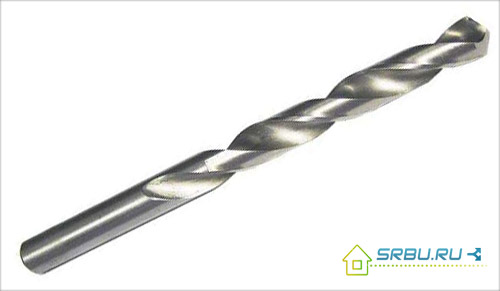
3. A few words should be said about the step-type drills that appeared not so long ago. It is very convenient for them to drill quite thin sheets of plastic, sheet metal, as well as roofing materials. Holes can be obtained from 0.4 to 3.6 centimeters or more.

We work with wood
If you have to make small holes (no more than 1.2 centimeters in diameter) in a chipboard or wooden surface, then an ordinary spiral drill for metal will cope with these. But large or high-precision holes are drilled only with a special tool designed to work with wooden surfaces. They are made of special tool steel, carbon or alloy. They are not suitable for metal. The following types of wood drills:
1. The twist drill is suitable for small and medium holes. Instead, you can take a drill for metal, but the hole will turn out a little worse quality.
2. Screw drill. A single-spiral type drill with a sharp edge for cutting is also called twisted. Due to the shape, similar to a screw, excess chips are well removed from it during operation. If you need to get a deep hole with smooth edges, you can not do without a screw drill.
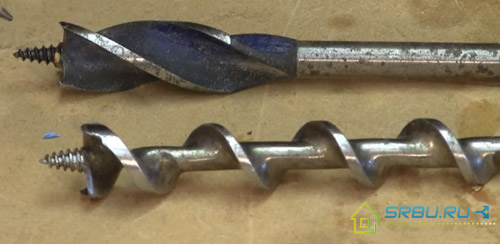
Above is a spiral, below a twisted drill on concrete.
3. The pen-type drill is suitable for making holes with diameters from a centimeter to 2.5 centimeters. The result is not very high quality - rough walls, approximate accuracy. But these drills can please an extremely low price.
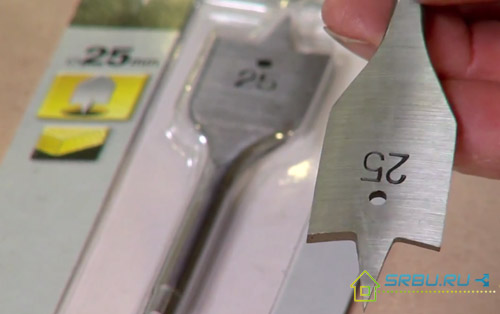
4. Crowns for wood. The drill, made in the form of a crown (ring), can be used when it is necessary to drill a hole with a diameter of up to 10 centimeters. Typically, the kit has one shank, mandrel and center drill.Crowns are included in the kit a few pieces.
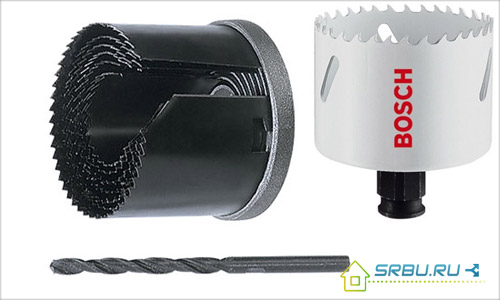
5. The Forsner drill has a center point and a sharp edge cutter. Thanks to him, the cut line is accurate. For blind holes with clear dimensions, this tool is great. They drill softwood, laminate and chipboard.
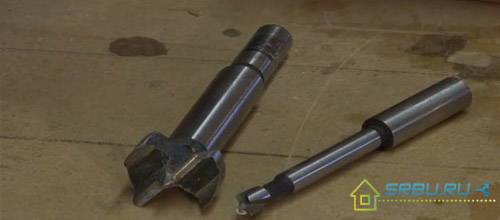
We work on concrete and brick
To work comfortably with surfaces such as brick, stone and concrete, you must have a drill with a solid tip. It is made of a special alloy, and drilling is performed using shock-rotational movements.
Unlike conventional drills with a shank of a cylindrical type, the drill used in a hammer drill can, in addition to a cylindrical one, have another shape. This is, for example, SDS-top, SDS-max or SDS-plus. Drills with SDS shanks are used for working with rotary hammers.
1. If you need to make a medium or small hole in concrete, take a drill or drill with a hard alloy tip. The shape of the tool is in the form of a screw.
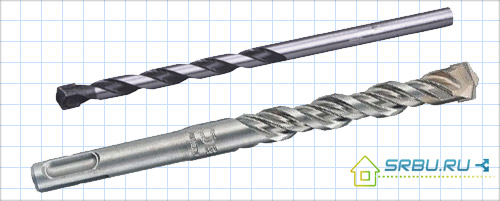
At the top is a drill for concrete, below is a drill for concrete for hammer drill.
2. We drill a large hole with a crown, which has carbide teeth on the edge. In this case, we use the method of impact drilling using a hammer drill. You can also use a tool that has diamond spraying. They work either shockless drilling with water cooling, or dry drilling. The core remains inside the nozzle - a cut piece of material.
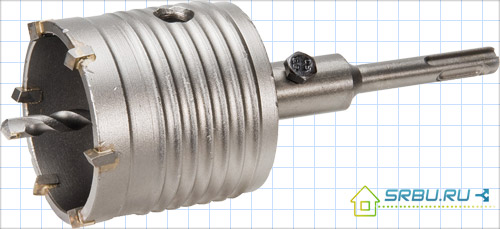
Winning drills can have a different quality - it depends on the brand of this material (won). To drill a granite surface, you need to take a drill having a plate of medium or high hardness pobedite. Medium soft or soft plates are suitable for soft concrete or brick. This must be taken into account when purchasing winning drills and drills.
We work on glass and ceramic tiles
It is more convenient to drill glass and tile with either a crown or a tool made in the form of a spear.
1. At a spear-shaped drill, the tip can be either victorious or made of tungsten carbide. In addition, there are diamond-shaped ring drills. If there is no special tool at hand, you can take a drill for concrete work, only sharp. And you need to work carefully - because this drill has a different shape.
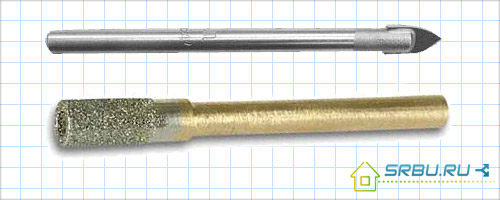
Lance-shaped drill on ceramic tiles, and below the diamond-coated core drill.
2. But the crown on glass or ceramic tile looks about the same as the crown for concrete work, but it does not have teeth, but only spraying.
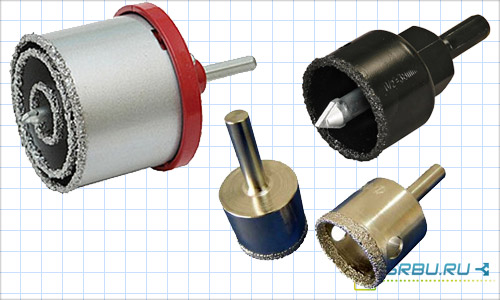
3. Tiles can be drilled with special ballerinas. They come in handy if you need to make a big hole. Drill carefully, from the wrong side of the tile, setting the drill speed to a minimum.
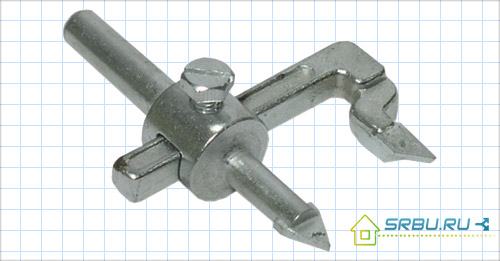
We drill everything
Perhaps the classification of drills will be incomplete, if not to mention universal drills. Finishing the premises, such a tool can work on almost all surfaces. Brick with concrete, tile, wood with plastic, aluminum, steel - the all-purpose drill can handle all this. He also has a tricky sharpening, which, by the way, is also called universal.
Video. Types of Drills

